
Dania Roberta Acevedo
and Romero Britto
Miami, Fl
2007
To return to Home Page click here:
www.vivabrasilmagazine.blogspot.com Email us: viva.brasil.magazine@gmail.com
Editorial / And the Carnival arrives...
 By Dania Roberta Acevedo
By Dania Roberta Acevedo
April 2006
And the Carnival finally arrives... bringing with it the essence of thejoy, cadency and magic of our people. Suffered people, but happy bynature. People blessed by God and the "Orixas". People who believe that 4 days is enough to renew the energies and hopes for better days. Brazilianpeople. My people.
And Singapore, one far little dot in the map, thismonth also tinted itself with yellow and green.. Many Mardi Gras and some Carnival celebrations around the island.
And here, far away from ourauthentic Carnaval and everything it represents, ourselves - 416 revellers misguided – have our responsibility to transmit to Singaporeans its true meaning..
Even here we must feel proud of being Brazilian. Not just for the aroma of the Churrasco that has been proliferating lately in this island. Or, not just for the great favouritism to be the Sextuple Champion in the World Cup. But for everything else - and there are so many other things - that carried through Brazil in Singapore.
It is up to us, 416 Brazilian citizens, to keep our traditions and the spirit of our country alive. This is Our Brazil.
I hope that the following pages, and future editions, this magazine fulfil these expectations and make ourBrazilian presence to grow greater in the coming years ahead.
Viva Brasil !
Events
Latin CircleSince its opening, almost a year ago, the Las Lilas School has come through an admirable and intense work of diffusing Latin America's culture in Singapore by highlighting its respective aspects of language, idiosyncrasies and lifestyle. It is important to stress that Las Lilas is the first Spaniard school to be established in Singapore.
This time in a joint effort with the Latin Circle led by Alejandra Grobet, they will be organizing a BRAZILIAN CARNIVAL. The event will take place in the most liveliest spot in CHIJMES, the CARNAVAL PUB & FUN BAR. The Carnival will be featuring authentic Brazilian music, dance, special Brazilian cocktail (caipirinhas) and a lot of fun. It will feature a fancy costume contest which will award prizes to the 3 best dressed and originally suited attendees.
During the event, the second edition of VIVA BRASIL MAGAZINE will be launched. This edition will focus on 2 of our main national passions; CARNIVAL and SOCCER.
Events
 INSEADBRAZILIAN WEEK
INSEADBRAZILIAN WEEK
During the month of January the INSEAD (Business School) was literally painted by yellow and green colors.
The Brazilian students and partners of the MBA program organized a full Brazilian week to showcase a little bit of our culture.
For the opening session, were received the Ambassador of Brazil in Singapore, João Gualberto Marques-Porto, the Minister Affonso Santos, the Secretary Renato Lima and the Director of EMBRAER in Asia, Dr. Wilson Nishida, who presented an informative lecture followed by a sumptous cocktail sponsored by Perdigão.
To fulfill the schedule of the event we had: Brazilian movies; a Capoeira Workshop and Roda presented by Master Ousado's group; a dinner at Samba Churrascaria and a very cheerful party at CARNAVAL PUB to end the week with a 'gold key' as we say in Brazil.
The typical Brazilian way to conquer the world.

From left to right:
Marina, Vincent, Bruno, Germain, Regina, Andre, Larissa and Mari (Studants and partners INSEAD)
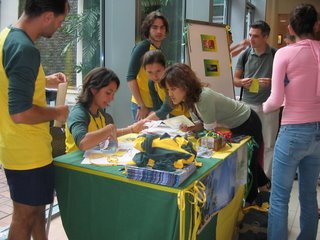 The Registration Desk
The Registration Desk
 Vicent Baron 9INSEAD) and the Ambassador of Brazil Jao Gualberto Marques-Porto
Vicent Baron 9INSEAD) and the Ambassador of Brazil Jao Gualberto Marques-Porto
Company feature
Perdigao:
The presence of Brazilian Chicken in Singapore
Even though a substantial group of Singaporeans are vegetable and fruit lovers, the consumption of chicken through the years is very significant in this island. It is in fact given top preference for source of meat protein, as well as most affordable, followed by fish and seafood.
Chicken is also a very versatile dish, according to the different ways of preparation.
Perdigao is a very traditional and well-known trademark in Brazil and the most important company that provide frozen chicken to Singapore. Perdigao products come from the safest origina as they are produced in Brazil.
On the other hand Perdigao is also an enthusiastic supporter of the diffusion and have helped to cultivate different aspects of Brazilian culture in Singapore through events such as the Brazilian Week at INSEAD, Carnaval at Holland Club and the Carnaval Bar at Chijmes.
Advertorial
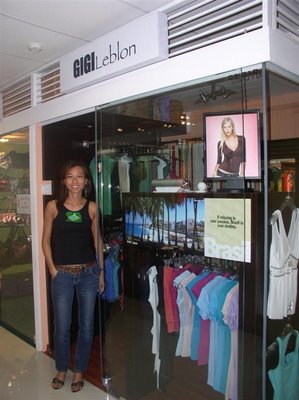
GIGI LEBLON
The entrepreneur Gigi Ng, who shares her passion for Brazil with her husband, Sasha, has recently successfully launched a fashion store, Gigi Leblon.
Opened in February, the store sells imported Brazilian fashion for women featuring characteristic Brazilian style and colors, including tops with Brazilian flag.
How to get there:
Located at Icon Trendy Zone, across the street (North Bridge Road) from McDonalds in Parco Bugis Junction. Lift and staircase access provided.
Icon Trendy Zone
530 North Brigde Rd, # 05-01D - Singapore 18847
HP: 9144-1414 / 98-1515Ctc Mrs. Regina or Mr. Sasha
E-mail: gigi@gigileblon.com
http://www.gigilebon.com/
Events
Patricia Russo, Daniela Everest, Christiane Pinto and others members of Brazilian Community.

 HOLLANDSE CLUB CARNIVAL
HOLLANDSE CLUB CARNIVAL
On 11 March 2006, The Hollandse Club marked the Brazilian Ball, and the title makes reference to the fusion of Carnival and Football.
At an affordable rate of $15 for members of the Brazilian community and club members, and $25 for invited guests; the event reached its goals to join approximately 500 people.
The Brazilian company Perdigao, who has supported strongly Brazilian national events in the island, once again marked its presence by sponsoring the chicken snacks that had been praised by the guests.
The entertainment was provided by 3 talented live bands. The highlight was The Grove which featured a dear friend of ours, Ivete Atienza.
Other highlights included the raffle draw, the colourful costumes, contests to get guests involved and performances.


Sports
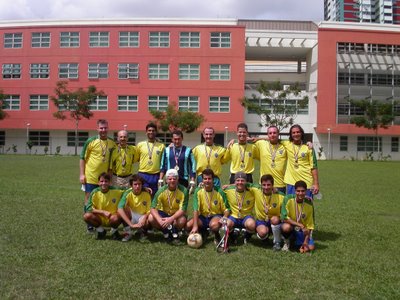 Brazilian Football in Singaporeby Fabio de CastroApril 2006
Brazilian Football in Singaporeby Fabio de CastroApril 2006For several years, a group of Brazilians living in Singapore have kept our great passion alive here by the Asian latitudes... which is our traditional Sunday football game.We are a squad of Brazilians and some foreigners of all ages (16 to 45) playing for the Brazilian F.A., participating in tournaments and friendly games.In the most recent years, our team has achieved some great results in local leagues being supported by our sponsor Petrobras.
-Champion of APEX League (2003 and 2004)
-Champion of Ambassadors Cup (2003)
-Vice-Champion of Singapore Football Challenge (2005)
If you want to join us, just give a call to 98273794 (Fabio/Team manager) or 98007322 (Zoroastro/Coach).
Brazilian Community

From left:
Danielle Ribeiro, Graziela de Souza, Juliana Tritto, Patricia Russo, Otilia Pesce, Daniela Everest, Andrea Marzullo e Laila Mallet.
The Portuguese Meetup
Dear friends,
My name is Justin and I have been the organizer of the Singapore Portuguese Meetup since 2003. However, because of the lack of people showing up at the meetups, the Singapore Portuguese meetup became dormant.
Portuguese is a really beautiful language, but this language is hard to come by in Singapore. The only two schools here that conduct Portuguese classes are Berlitz and Chambers. Even then, classes can only start when the minimum number of students for each class is fulfilled.
A good friend of mine, Carlos Pheysey, conducts private Portuguese lessons for Singaporeans who are interested in learning the language.
The Singapore Portuguese Meetup was established for the sole purpose of providing a platform where Singaporeans can meet Brazilians and have a chat in Portuguese.
This is an invitation to any Singaporean who is interested in learning the language. For those who are keen to learn simple Portuguese phrases, come early please!
Yours faithfully,
Justin Ee
Artists
 Brazilian Art with and Oriental FlareThe painter Heloiza Montuori
Brazilian Art with and Oriental FlareThe painter Heloiza Montuori
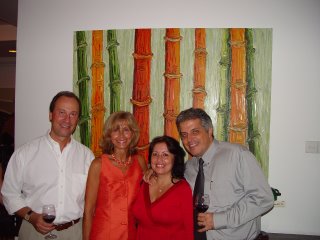 Mario Montuori, Elegie Santini, Solange and Jorge Antunes
Mario Montuori, Elegie Santini, Solange and Jorge Antunes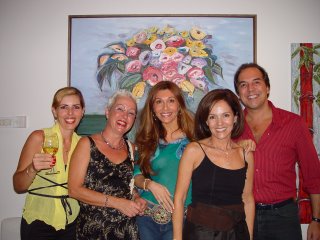 Christiane Pinto, Deise Cavalheiro e amiga, Heloiza Montuori and Dr.Marco Faria-Correa
Christiane Pinto, Deise Cavalheiro e amiga, Heloiza Montuori and Dr.Marco Faria-Correa
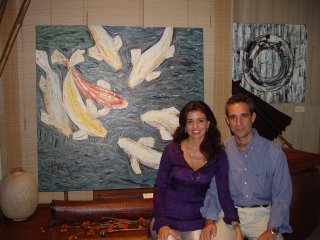 Patricia Russo and Eduardo Autran
Patricia Russo and Eduardo Autran
Dressed totally in black, in order of not to draw away the luminosity that emanates from her paintings,
Heloiza Montuori, artist by nature and painter by conviction, entertained her admirers and closer friends with a true feast of colours for the eyes, during an Open House recently held at her cozy home.
Goga, as she is affectionately known, is one of our national prides in Singapore where she has been living for more than 2 years together with her husband, Mario Montuori.
With her elegant and easy going style, Goga transmits in her paintings, her warm personality allied to a certain oriental serenity.
In the pictures, captured moments of the event.
Traditions
 Photos: EMBRATUR- Brazilian Tourism Board
Photos: EMBRATUR- Brazilian Tourism Board
THE BRAZILIAN CARNIVAL


BRAZILIAN CARNIVAL
By Larissa Rios
In Brazil, the Carnival is the biggest popular manifestation besides football.
Surprisingly, the origin of the Brazilian Carnival is European. It dawned in the beginning of the colonization and it was bequest of the Portuguese entrudo, a popular street party.
Officially the Brazilian Carnival starts on a Saturday and ends on a Tuesday. However, in some cities, the festivities can stretch to more than a week, not including the so-called previas (preview), which occupy the whole of summer.
Each region has different manifestations, but the spirit of happiness and detachment take hold of all Brazilians, without any prejudice, creating an atmosphere of dream and illusion which will fascinate the world during the days of the carousal. The whole of Brazil is infected with the energy of the party and the biggest manifestation of Carnival are resplendent in Pernambuco, Rio de Janeiro, Sao Paulo and Bahia.
In Pernambuco state, the Carnival of Olinda is inhabited by dancers, Pierrots and Colombinas. A t seven o'clock in the morning, the first chords of the 'frevo' can be heard among the crowd. Close to a million people following the music on the streets, jumping and dancing in a crazy rhythm, following rows of dressed-up revellers and huge mascot puppets.
Rio de Janeiro offers one of the greatest shows on earth: the Samba Schools parade. So important is the parade to the local culture, that it has been given its own venue: the Sambodromo. A space for the spectacle's presentation and for the audience, as the procession passes along its 800m extension.
Each Samba School has its own unique theme represented through the costumes and the samba-enredo (sound track). Themes are created by the carnavalescos, professionals who are specialized in using their imagination to form the conception of the parade. The Samba Schools have lots of participants (the bigger ones can claim up to 4,000 people), all dancing and singing in a unique rhythm generating a truly exuberant sound and visual.
The Samba School parade also characterizes the Carnival of Sao Paolo. As in Rio de Janeiro, Sao Paulo has a Sambodromo especially projected by Oscar Niemeyer for the Samba Schools parade: the Anhemi Sambodromo.
In Bahia, the biggest attraction would have to be the Trios Electricos, enormous truncks converted into stages, blaring out the contagious Axe-Music at a phenomenal volume. With the Trio eletrico comes the Blocos, a group of revellers dressed in the same costume.
In the command of the Blocos are the stars of the Carnival of Bahia: namely Gilberto Gil, Caetano Veloso, Ivete Sangalo, Daniela Mercury, Chiclete com Banana, Asa de Aguia, Olodum and more.
The Carnival in Salvador de Bahia attracts around 2 million people every year and it's comprised of more than 100 Blocos which during seven days, makes more than 26km divided into two circuits, entertaining the crowd. This is exactly why the Guinness Book rates this as the greatest street parade in the world.
This is the Carnival in Brazil. A party, a moment of music, union, fantasy, which reveals the real cheerful, creative and irreverent essence of the Brazilian people.
Tourism

Rio de Janeiro
by Christiane Pinto
April 2006
High beat, diversity, mixture of people from various parts of the world, shops, cinema, theatre, music for all tastes, politics of all trends, night life, art, culture and architecture. In short, the world in one place: Rio de Janeiro.
Rio is a city to be heard, admired, explored and discovered. Thanks to its natural beauty and the hospitality of the people who live in Rio, named cariocas, the city has become the portrait of Brazil. Muse who has inpired various artists, was first inhabited by local Indian aborigines called Tupi who were expelled by the Portuguese during the colonization of Brazil when they landed at the Guanabara Bay on March 1, 1502. Soon after, the French came but were forced to leave the country when Estacio de Sa declared the city officially established. In 1763, Rio became the capital of Brazil until Brasilia contruction was finalized in 1960.
The city of Rio de Janeiro is a preferred destination not only for foreigners who visit Brazil, but also the Brazilians themselves. Its beautiful beaches, its restless night life, its traditional neighbourhoods and its most famous tourist attraction known by the whole world, attracts more and more the ones in search of culture, entertainment, adventure and beautiful sceneries.
Thanks to its vast options for leisure, the city can be enjoyed wherever you are. If you are in search of culture, the city downtown is the right place. There you can find museums and historic places which were built during the time of the Portuguese colonization and the early days of the Republic like Cinelandia, which was considered the Brazilian Broadway in the past. The city is also full of charming neighbourhoods where you can listen to very traditional music called chorinho, which has a rhythm as involving as the samba.
The beaches are one of the main attractions in the city. In the very crowded streets of Copacabana, you can see tourists from all over walking around. They love going to Ipanema to enjoy the most delicious food Rio can offer. Many also walk by the Vinicius de Moraes Street and stop at the bar where he and Tom Jobin created the song, The Girl from Ipanema.
Another attraction which creates moments of excitement and admiration to the heart and eyes of those who see is the Sugar Loaf mountains, where you can see the most spectacular and unforgettable view of the city. And how about the Redemer Christ? Located at the top of a mountain in the heart of the Tijuca forest, this 38 meter tall statue blesses and spreads peace and beauty to this wonderful city. When it comes to enjoying the romantic moments, nothing better than seeing the sunset at Arpoador. The breeze, the sun touching the sea, the waves and birds flying over the coast are part of the scenery for those who are in love or simply go in search for peace.
The city is also considered world reference when it comes to Carnival. It is at Marques de Sapucai that the most beautiful Brazilian show takes place: the samba schools parade. This is where luxury meets with joy and beauty. The made up cars representing various themes, the sound of the drums and the dance are part of the city for 4 days and engages everyone with no exceptions.
Rio de Janeiro is a wonderful city full of charm, it is the heart of my Brazil.
Rio is very easy to access as there are flights from all 4 corners of the world. It is really worth adding Rio to the list for your next vacation.
Our Christ will be there with his arm wide open to welcome those who want to visit us.
Events

LATINASIA BIZ FORUM 2006
The LatinAsia Biz Forum, initiated by International Enterprise (IE) Singapore in 2004, is Asia’s premier business conference on Latin America.
This annual event highlights new business and investment opportunities in Latin America and provides an interactive platform for business dialog between Latin American and Asian companies.
A host of distinguished speakers from both the business and government sectors will share their market experiences, insights and expertise, offering an opportunity to understand and develop strategies for doing business in Latin America and to forge partnerships between companies based in Latin America and Asia.
The LatinAsia Biz 2006 Forum will address key marketing, logistics, business culture and partnership issues related to doing business in Latin America.
The LatinAsia Biz 2006 Forum will be held on 14 September 2006 at the Regent Hotel, Singapore.
FHA 2006 FAIR
"FOOD & HOTEL ASIA"
By Carlos Pheysey
April 2006
Coming up is the new edition of the biennial fair FHA 2006 - "Food & Hotel Asia", to be held from 25 to 28 April, 2006, in Singapore.
It is the largest foodstuff fair in Southeast Asia, for which is foreseen the participation of 3,000 exhibitors and 40,000 visitors from Asia and the world.
In 2004, Singapore imported from Brazil a total of US$380 million in foodstuff, beverages and tobacco, chiefly meat products, coffee items, tobacco leaves, alcoholic beverages, chocolates/cocoa, fruit and juices, and more.
Singapore acts as the main reexporting harbour worldwide, focal point for the distribution to all of Asia, without Customs duty tariffs on imports by (save for tobacco and alcoholic beverages), or transshipment through Singapore.
Brazil is the 7th largest supplier of apples to Singapore. The Brazilian exhibitors have already booked space in the Brazilian aisle (sector 3B2-01) of hall 3 of the complex Singapore Expo, pavillion under the aegis of IBRAF, the Brazilian Fruit Institute.
For instance, the company named Atlântica will exhibit a processed form, powder from fruit. There is potential for tangerines and grapes. The distance Brazil-Singapore prevents the feasibility of fruit easily perishable, but one can consider processed formats: juices, cristallized guava-paste, jams, etc.
The Brazilian booth aims to showcase the best in technology, sanitation and large agribusiness management in Brazil, the greatest agricultural power globally and currently a silo for the world. Thousands of Brazilian producers are already registered in
www.braziltradenet.gov.br , multiplying the Brazilian exporting presence worldwide.
Gastronomy
Brazilian Churrascaria by Mamma Lucia

The Brazilian
passadores (meatcutters) standing next to
Britto's "Let me Think" (Acrylic on Canvas 40" by 30")
 Clearance Ling
Clearance Ling, Co-owner of Mamma Lucia pictured with
Mauro Orsini Gravina invest highly in
Britto's art pieces.

The australian model Amanda Kay proudly exhibit Britto's Apple
Brazilian Churrascaria by Mamma Lucia: Brazilian Art and food
By Dania Roberta Acevedo
A soft breeze was inviting us to sit in the outside tables on the walkway which, by around 7.30 pm, were pracatly all taken. In the bar which has also direct access to walkway, patrons waiting for their tables, will be chatting and drinking beer, not too anxious to get in.
In the meantime, the romantic presence of the moon, shyly insinuating over the tall buildings, was suddenly changed by the comfort of the air conditioning as soon as we crossed the main entrance.
Happy voices in different languages; clinging from glasses of wine, celebrating specials moments; and effusive laughs, framed the atmosphere of the Mama Lucia Churrascaria which, not dening it's Italian origin, proudly exposes its authentic Brazilian side.
Once settled, one can observe the synchronized choreography of the experienced "passadores" (meat cutters) who served generous slices of the best of Brazilian meat and other delicious treats imported all the way from our beloved land.
For white meat lovers, both chicken and fish skewers exceeded expectations of the most discriminating tastes.
Immediately various side orders such as our rice and black beans, "farofa", fried plantain and steamed vegetables were served.
Although most costumers appreciate the comfort of food been served at the table, very soon the Restaurant will have an extensive buffet for salads and cold meat.
On the walls of the Restaurant a pleasant and unexpected surprise: two original art pieces from renowned Brazilian artist Romero Britto whom, for second consecutive time, is the cover of our magazine Viva Brasil.
To close the evening in a high note, a vast parade of homemade ice creams and "gelatos" served in its own fruit and several other options for those with a sweet tooth.
Mama Lucia Churrascaria also possesses a large list of wines and beers, including Brazilian brands, and its own Italian house wine, produced at the owners winery in Italy at an affordable price of $ 25 per bottle.
Brazilian Churrascaria by Mamma Lucia, which charges SGD 38 per person, is located a few steps from the lively Mohamed Sultan and has a capacity for 120 patrons. Advanced reservations are recommended for large families and corporate groups.
Without a doubt, Mama Lucia is high light in the city.
Brazilian Churrascaria by Mamma Lucia Churrascaria
11 Unity St.#01-03 Robertson Walk
Singapore 237995
Tel.(65) 6732-3357 Fax. (65) 6732-3395
e-mail: franchise@fintrex.com
www.fintrex.com
Company feature
 Bruce Peddle, Managing Director, Asia-Pacific
Bruce Peddle, Managing Director, Asia-Pacific
 Embraer - Legacy 600
Embraer - Legacy 600
EMBRAER
EMBRAER is the world's leading manufacturer of commercial jets up to 110 seats, with 36 years of experience in the design manufacturing and after sales support of jet aircraft for the worldwide airline, executive and defence markets.
Headquartered in São José dos Campos, Brazil, EMBRAER is a global company with offices worldwide, including the United States, France, Portugal, China, and a regional office for Asia Pacific in Singapore.
The Brazilian company's growing commitment to Singapore and the rest of Asia is reflected in its strong participation at the recent Asian Aerospace 2006 Air Show, held at Changi Exhibition Centre, Singapore from 21 to 26 February.
For the very first time at the show, EMBRAER displayed its Legacy 600 executive jet – a premium private jet that seats up to 16 passengers. Embraer also announced the sale of two new Legacy 600 jets to Jakarta-based PT Ekspres Transportasi Antarbenua (Premiair) and another undisclosed company in the region, at the show.
"Asia is seeing a strong resurgence in business aircraft demand. This can be attributed to the recovery of the Asian market since the 1990s financial downturn. Individuals and corporations are increasingly relying on high-quality charter aircraft to gain access to developing markets throughout the region," said Capt. Manfred Baudzus, Regional Sales Director, Asia Pacific, Executive Jets Market.
In the defence sector, EMBRAER displayed the Super Tucano military trainer aircraft for the first time on the Asian continent. Following the show, the military trainer toured other parts of Asia and the Middle East, giving air forces in the region the opportunity to evaluate the aircraft.
EMBRAER also clinched the Air Transport World magazine's Aviation Technology Achievement Award at a gala dinner held on the eve of Asian Aerospace 2006.
Each year, the award goes to a manufacturer serving the airline industry through the development of a product seen as significantly advancing airline service, capability, efficiency and safety. This year EMBRAER was recognised for the Models 170/190 family which comprises four new-generation jetliners tailored to right-size airline capacity in the 70-to-110 seat size.
"We made some significant inroads in Asia last year, and we are confident of establishing an even stronger business presence in Asia this year," said Bruce Peddle, Managing Director, Asia Pacific, Civil Aircraft Market.
In 2005, Hong Kong Express Airways Ltd, based in Hong Kong, operated the first EMBRAER 170 and will shortly operate a fleet of four aircraft linking Hong Kong and cities in mainland China. The EMBRAER 170 also entered revenue service with Paramount Airways in October 2005, becoming the first customer for the E-Jets in India. Paramount Airways will take delivery of another EMBRAER 170 and three EMBRAER 175s this year.
In addition to the recent Legacy 600 orders in Indonesia , EMBRAER also delivered four specifically configured Legacy Executive aircraft to the Indian Air Force and one Legacy aircraft to India's Border Security Force last year.
EMBRAER is among Brazil's leading exporting companies. As of 31 December 2005, the company had a total workforce of 16,953 people, and its firm backlog totaled US$10.4 billion. As the markets in Asia continue to evolve and grow, Embraer looks set to invest further and establish a stronger business presence in this part of the world.
Sports
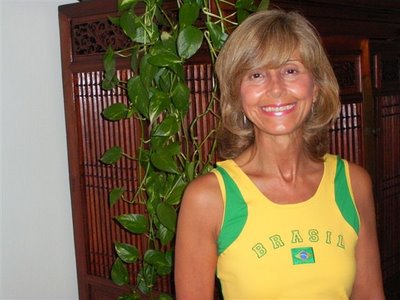
Football, a national passion
By Elegie Santini
April 2006
"In Brazil, football is not a sport. It's a ball's game, where astuteness and dribbling are a must. It's a game that reflects the nationality of a country dominated by the passion for the ball.
During a game, Brazilian players may forget the objective of scoring goals, so convinced they are that the virtue without happiness is a contradiction."
("The Country of the Ball", Betty Milan)
Two simple wooden sticks or two stones are good enough to mark the goals. A couple of old socks or crushed paper can turn into a ball. Once chosen the teams, the game starts bringing magic with it. Behind the ball runs anyone: black, white, fat and slim guys, rich and poor. Everybody united by the same passion: football.
This sport that mobilises the Brazilians, as any other sport does, has its origins in 2500 BC in China, having reached the Ancient Japan, Greece and Rome. In the Medieval Italy it was transformed in a game called gioco de calcio, played in public squares by 27 players in each team whose objective would be to bring the ball to the posts installed in the two corners of the square.
According to specialists, gioco de calcio was brought to England approximately in the 17's century. The game then starts getting new rules and become more organized and systematised The measurements of the field are established, as well as the two posts installed in the extremes of the field, that would be called "goal".
It is also established that the ball would be made of leather and inflated with air. With clear and objective rules, football was then practised by students and the English aristocracy, and little by little getting more and more popular.
In 1863 the Football Association is founded in England and the first championships are organized among teams formed by workers from the various factories that abounded in the country.
That is when people started identifying themselves with their football clubs, be it for community, cultural or even religious reasons. Later, in 1894, football arrives in Brazil, brought by Charles Miller, a Brazilian born in the traditional district of Bras, in São Paulo.
When Miller goes to England to study, he learns the sport and brings back in his luggage the first soccer ball and a couple of rules. Miller was not only the "father of Brazilian soccer", but also the first player to distinguish himself in the country due to his extreme ability.
It doesn't take long for the Brazilians to be more and more interested in the game and, in 1898, the students from the Mackenzie College in São Paulo found the Mackenzie Athletic Association, created with the sole purpose of playing football.
Soon after, other clubs were founded in various states of Brazil, like the São Paulo Athletic, Sport Club Internacional , Sport Club Germânia, Sport Club Rio Grande and Associação Atlética Ponte Preta, in Campinas.
In 1901 the São Paulo Football League is created. One year later Fluminense Futebol Clube is founded in Rio de Janeiro and Sport Club Corinthians Paulista in São Paulo. Flamengo appears in 1911.
With the creation of the first Brazilian Sports Federation in 1914, Brazilian football is already well organized and participates in its first international game, against the English team Exeter City, with a team formed by players from Rio and São Paulo.
Around 1922, the first Brazilian soccer 'stars' pop up, like Luis Macedo Mattoso, "Feitiço". However, the moment of glory – and tragedy – would come in 1950, when Brazil would host the first World Cup after World War II.
In the Maracanã stadium, built to house the Cup, people would watch some of the finest and unforgettable exhibitions of Brazilian strikers, like Ademir de Menezes - "Master" Zizinho - and Leônidas da Silva - the "Black Diamond" - who invented 'the overhead kick'. In each game, Brazilian passion would grow, fuelled by the magic of these stars. Nevertheless, as all passions, soccer also produces suffering, and this is what happened in that fatal July 16th game when, against all odds and expectations, Brazil lost the World Cup to Uruguay.
This happened in front of 200,000 people that muted Maracanã until the final whistle blow.
Everything died in that game, except the passion for soccer. Gradually energy picks up and, before the decade is over, Brazil would realize its maximum achievement with the Canary Team and the world would witness the birth of two of the major genius in soccer history: Garrincha and Pelé.
It was them – anonymous in 1950 – with their magic touches and dribbles, and commanded by a "prince" called Didi, who returned happiness to Brazilian hearts. Other conquests would be just a matter of time: in 1962, with a new show from Garrincha, and in 1970, led by "King" Pelé, Tostão, Clodoaldo, Gérson, Carlos Alberto Torres and Jairzinho, Brazil obtained the world tri-championship, unseen event in 40 years of world cups.
The rest is public knowledge: in 94 with Romários's fantastic performance, Brazil became tetra-champion and in 2002, at the first Cup hosted by two different countries, Ronaldo, "the Phenomenon" led Brazil to its penta-championship.
This is the "art soccer" of a country that has the most acrobatic players in the world. Dribble is a Brazilian invention and part of its tradition of "make-believe". This is why, in Brazil, soccer cannot be dissociated from "fun" which is our passion.
We have fun on our day-to-day activities, in Carnival and in soccer, because fun is part of our existence and constitutes a great spiritual resource of Brazilian society.
We are now approaching a new world cup where discussions heat up and hearts beat stronger. It is the "passion" that flows again. They say that in Brazil everyone is a "Coach". According to Paulo Cesar Vasconcellos "apart from being Coaches, every Brazilian is a player, an umpires or club president. Everybody knows tactics, game plans …". That is passion.
"Being world champions or not, we will always be the champions of the passion generated by a soccer ball" (Betty Milan)
Chronology and Curiosities of Soccer
· The first rules of the game were established in 1848, during a conference in Cambridge, England.
· Goalkeeper position was created in 1871.
· In 1875 the 90 minutes game duration was established.
· The penalty, a punishment for fouling inside the area, was instituted in 1891.
· In 1907, the offside rule was created.
· Oldest football club in Brazil: Sport Club Rio Grande, in 1900.
· First international game in football history: England x Scotland, 30 November 30 1871.
· First soccer game in Brazil: Gas Company x São Paulo Railway Company, 14 April 1895.
Did you know that Brazil was not always the Canary Selection ?
The green and yellow jersey, a symbol of the Brazilian team, was not the first Brazilian outfit. Until the 1954 World Cup, Brazil's jersey was white with blue collars. After the defeat to Uruguay, in 1950, Management decided to change the uniform and, for that, a national popular contest was launched in 1953. The basic criterion was for the uniform to have the four colours of the National Flag. The winner was a young "gaucho" (Southern Brazilian) of 19 years of age, Aldyr Garcia Schlee, who created the green and yellow uniform. This jersey made its debut in 1954, at the World Cup in Switzerland, and it was during that event that the radio commentator, Geraldo José de Almeida, coined the expression "Canary Team".
Editorial / God is Brazilian
The expression, 'God is Brazilian' is one of the most used phrases in my homeland.
More than just expressing our sense of humor, this popular phrase reflects a deep belief that we are truly a blessed country and we have more reason to be thankful than to complain. After all, we have an extended serpentine coast measuring up to 8.500 km with paradise beaches; we are preserved from contagious epidemics; from catastrophes and natural phenomenon such as earthquakes and hurricanes; we have wonderful weather; the land is fertile and we boast an optimistic population. This is an essential virtue to overcome the problems that faces a sub-developing country.
If God is not Brazilian, I believe he was generous enough to grant these privileges to the 180 million souls that live there. For whomsoever in us, due to certain circumstances in life, we had to leave our homeland and hence for the same circumstances we have distanced ourselves from our most deep sense of patriotism.
Being Brazilian gained a new meaning and commitment. We keep strong inside our own homes and families the habits, lifestyle and language as an essence of our culture. At the same time, exercising the muscle of our nationality, our sense of community and our love to Brazil.
Viva Brasil gave me the opportunity after several years to taint my heart in green – yellow. During the planning process I have caught myself many a time mesmerized by the breath-taking images of Brazil.
Simultaneously, I realized the enthusiasm of some virtually unknown people from the small Brazilian community determined to contribute to this magazine with articles and others sharing their experiences through hand written notes with tears in their eyes and lots of heart.Heart that I give to each one of you through the pages of this magazine.
Viva Brasil !
click here: www.vivabrasilmagazine.blogspot.com


 The Registration Desk
The Registration Desk 






 Brazilian Art with and Oriental Flare
Brazilian Art with and Oriental Flare Mario Montuori, Elegie Santini, Solange and Jorge Antunes
Mario Montuori, Elegie Santini, Solange and Jorge Antunes Christiane Pinto, Deise Cavalheiro e amiga, Heloiza Montuori and Dr.Marco Faria-Correa
Christiane Pinto, Deise Cavalheiro e amiga, Heloiza Montuori and Dr.Marco Faria-Correa
 Photos: EMBRATUR- Brazilian Tourism Board
Photos: EMBRATUR- Brazilian Tourism Board 



 The Brazilian passadores (meatcutters) standing next to Britto's "Let me Think" (Acrylic on Canvas 40" by 30")
The Brazilian passadores (meatcutters) standing next to Britto's "Let me Think" (Acrylic on Canvas 40" by 30") Clearance Ling, Co-owner of Mamma Lucia pictured with Mauro Orsini Gravina invest highly in Britto's art pieces.
Clearance Ling, Co-owner of Mamma Lucia pictured with Mauro Orsini Gravina invest highly in Britto's art pieces.
 Bruce Peddle, Managing Director, Asia-Pacific
Bruce Peddle, Managing Director, Asia-Pacific Embraer - Legacy 600
Embraer - Legacy 600